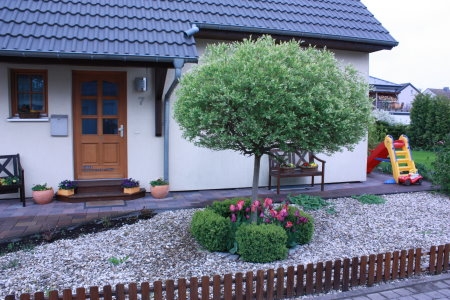Construction Save costs when building a house - Calculate Now
There are many ways to define a house, to identify house types, the most important of which are compiled here. Houses can be described according to construction methods and technology, style and design, or according to use, although mixed forms do occur.
One of the most common methods is to describe a house according to the number of living units. Then the range extends from the single-standing single-family house, to the semi-detached house, row house and apartment building, to the large apartment building, which in this country could degenerate into a housing machine. Failed artificial suburbs and clusters of prefabricated buildings as socialist achievements have become household words.
Calculate single family house construction costs
Single houses are and have been a privilege of wealthy builders, because they require the most building land, whether it is a prefabricated house, modular prefabricated house or solid house. These more construction specifications can also be observed in semi-detached and terraced houses. In the case of the single house and, to a limited extent, the semi-detached house, builders and architects can be more or less restricted in their design activities within the framework of a local development plan. Compulsion to flat roofs, gable alignments, building size and building material in the exterior construction have often limited the creative scope to the interior.
Architect house construction costs calculate
The "architect's house" is still the ideal conception of a single house. Here, the costs for a good architect are less important than the procurement of materials, the construction of building services and construction logistics. However, individual roof landscapes, terrace, pool and garden designs tend to cost considerably more than "off-the-peg" houses. Architects' houses also use higher-quality and usually more expensive building materials than standard projects. Comparative studies by architectural associations have shown, however, that additional costs incurred solely as a result of good design and not as a result of special requests from builders have been in the range of five percent for additional costs.
Energy-saving house cost calculator
The single house, whether a classic one-story bungalow, maisonette or architect's villa, requires the greatest amount of energy-saving measures, but often also allows the greatest latitude in the design of decidedly low-energy houses. With tolerant building authorities, design and energy-related construction technology can be best realized in the single house, up to eccentric house models that, rotatably mounted, always face the sun. General regulations on energy-saving measures are spreading through the legislature anyway, but a low-energy house needs more than thermal insulation. In many of the mostly singular houses, the complex and expensive technology for energy generation and storage must additionally be reflected in the design, and it must also be accommodated. Energy-saving houses that are connected to a decentralized municipal or cooperative heat supply, for example from geothermal energy or commercial waste heat, can do without large-scale hot water tanks.
Calculate sustainable timber house construction costs
Construction technology plays a greater role in design scope than in durability. Wooden houses in Scandinavia - also in prefabricated construction - have proven to be just as weather-resistant as Central European brick houses. Attention must be paid above all to the moisture protection of the foundation or basement and the quality of the roof and its supports. At these two transition points to the wall structure, solid houses that are poorly constructed or not sufficiently adapted to the climate and environment can also suffer early damage. In North America, wooden structures made of naturally durable wood have proven to be very resistant. However, the still widespread use of redwood from the cypress family has led to lasting environmental damage there due to misguided forestry policy and timber management.
Wooden houses also include log houses, plank houses, and in mixed technique Bundwerkhäuser, as they are still built in the alpine European region. A subgroup of timber houses are half-timbered and post-and-beam houses, whose diversity, which is also influenced by the landscape, cannot be further explained here. They, too, are well manageable in terms of energy technology and durability and stability. Scaffold or stud frame metal buildings are easier to retrofit than conventionally constructed buildings. Houses, especially apartment buildings with oversized glass surfaces in the succession of Bauhaus architecture went out of fashion because of insulation problems. However, they can still be realized with the appropriate technical and financial effort. Basic structures made of metal and also reinforced concrete give rise to special problems of heat and sound conduction. They must therefore be very precisely calculated, constructed and free of so-called bridges.
Calculate multi-family house costs
Multi-party houses are generally more favorable than single houses in terms of thermal insulation, prime costs and maintenance costs. However, the sound insulation within the building must be particularly well designed to prevent annoyance to other parties, so that the still typical shortcoming of many rented houses does not occur, in which one can hear the neighbor coughing and the toilet flushing from the other end of the building. In the context of multi-party houses, there is the luxury variant of the penthouse, which, however, with few exceptions, must be viewed constructively like a single house.
House types can also be described in terms of the basic cost price. Here, the term "low-cost house" is increasingly gaining acceptance, but this does not indicate a lack of or inferior construction. Typical cheap houses are the prefabricated houses graded in the price structure, which reach from the complete house up to the partially individually arranged module house, with which differently than with the owner house above all the building services can be calculated more favorably because of the standardization. This applies also with the house purchase of developers. Above all from the Netherlands the tendency is increasingly taken over not to build houses with a basement. There, it makes sense especially for housing developments on polder land because of the groundwater issue. However, the closed foundation slab above former seabed has primarily a protective function, which results in the so-called "cheap house" as a by-product.
Feng Shui house construction costs calculate
A special form of varied house types is created when building houses in Feng-Shui settlements. They represent, not least because of the Feng-Shui teachings, a mixed type of builder and developer models. Feng Shui houses are adapted to certain settlement designs and ideal ideas of house types and material use, but leave the buyer or builder only limited design options and are not necessarily savings objects even with inexpensive building materials. From a purely technical point of view, Feng Shui houses hardly differ from conventional constructions.
Modern exposed concrete house costs calculate
If one divides house types however still after basic styles and partly regionally usual building material, no borders are set to the variety. House walls can be masonry or cast concrete, plastered, finished or clad. Exposed walls can be built of wood, bricks (clinker) or with house stones and glass tiles. Pitched roofs, gable roofs or hipped roofs can be single-firsted, multi-firsted or curved with shingles, thatch, slate and roof tiles made of tiles or special concrete.
A house type can be based on historical models, adapted to the English or Low German country house style, Upper German traditional forms or classic suburban villas. A house type can be conventional or functional. Ideally, a house is a public calling card for its occupant and is designed to last more than its own lifespan. Our housing culture is not yet dominated only by throwaway architecture and mobile homes.
Topics: building & Living & Real Estate



